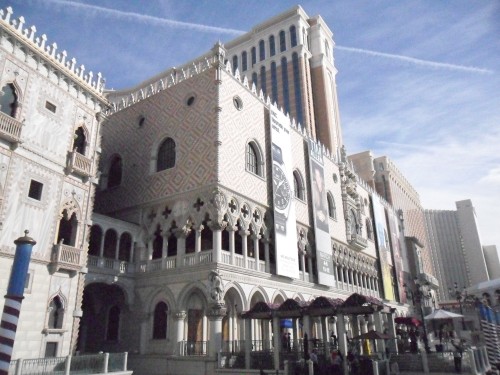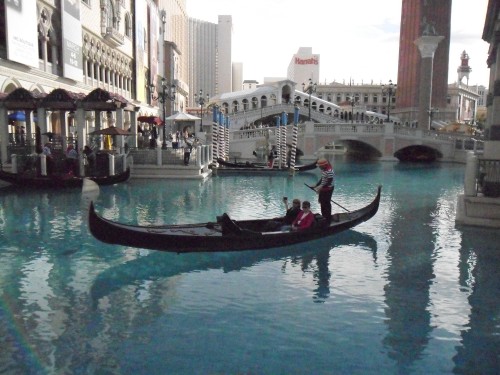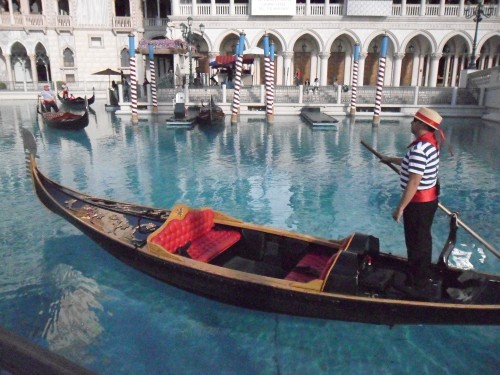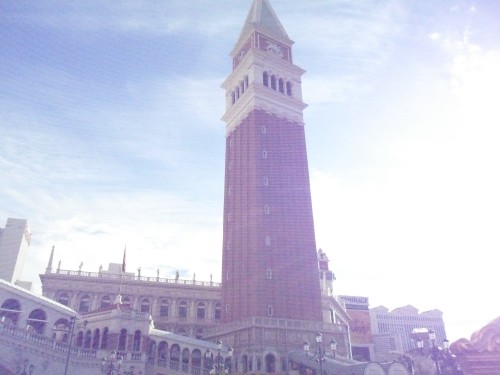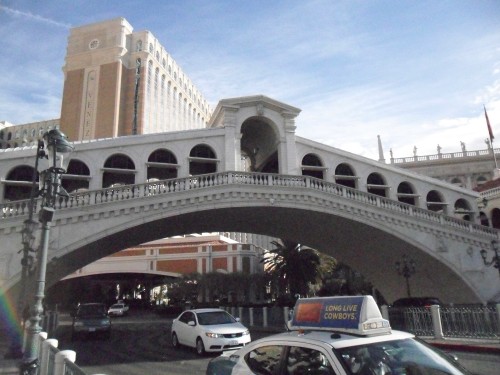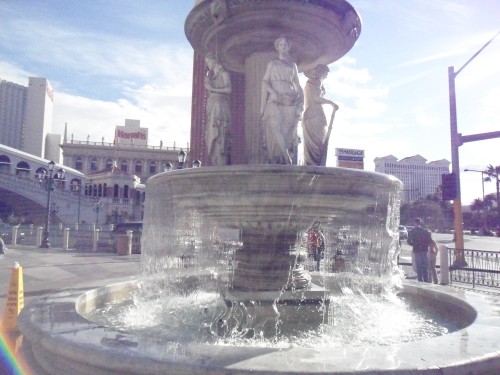After a good night’s sleep at the Marriott Residence Inn on Paradise Road near the Las Vegas Convention Center, we drive to Las Vegas Boulevard South and park the car on level 8 of the parking complex. We descend the elevator that is about to transport us to Venice, Italy.
The usual interpretation of the architectural reproduction of other parts of the world (Venice, Paris, New York, Egypt, etc.) in Las Vegas is that it is an elaborate fifth dimensional illusion devised to distract the gambler from the fact that he is being separated from his money in the alleged ripoff business that allegedly is casino gambling.
But the reality of what Las Vegas architecture has achieved exceeds the intentions of the casino hotel owners. “Learning from Las Vegas” (Robert Venturi) today is to learn that virtual experiences created through technology and design are just as real as so-called “real experiences.” And it is to learn that Venice is an idea. Paris is an idea. New York is an idea. An idea can be expanded and extended. Venice is not restricted to its physical location in the region of Veneto in northern Italy. Embodied semiotics is what makes reality. I am physically in Las Vegas but I am really in Venice. “Culture has never been anything but the collective sharing of simulacra.” (Jean Baudrillard, The Fatal Strategies – TFS)
It’s time for some lunch.
The architecture and décor of the Grand Lux Café was inspired by the look and feel of classic Venetian cafes. For lunch, I will have the Quattro Stagioni or “Four Cheeses” pizza: mozzarella, parmesan, romano, and fontina. Then the spaghetti alle vongole (with clams). Followed by a combination platter of shrimps scampi and Mediterranean mahi mahi. And a diet pepsi please. Gotta watch my weight.
At each casino that I visit, I win exactly 80 dollars, no more and no less. I play several hands of blackjack and get ahead $40. Then I put the $40 in chips on “red” at a roulette table. I win, I double my money, and I leave. I go to the cashier’s window. “Gaming is wonderful, because it is at the same time the locus of the ecstasy of value and that of its disappearance.” (TFS)
“Scusi, signorina, lei pensa che si rovini l’appetito per la cena se mangio cinque pezzi enormi di cioccolato fondente?” (“Excuse me, miss, do you think that it will ruin my appetite for dinner if I eat five huge pieces of chocolate fudge?”)
“Let me recommend instead that you eat an entire box of Oreo cookies (the ones with the chocolate fudge covering), or would you prefer the Italian equivalent thereof? I’m sure that consuming just one box of cookies won’t spoil your appetite for dinner.”
“Yet his means are in supposition: he hath an argosy bound to Tripolis, another to the Indies; I understand moreover, upon the Rialto, he hath a third at Mexico, a fourth for England, and other ventures he hath, squandered abroad.” – Shylock in The Merchant of Venice. The famous Venetian bridge was a hub of anti-semitism in Shakespeare’s time. At today’s Las Vegas Venetian hotel: a nice Jewish deli called The Rialto.
What is a ceiling painting? In the 1965 film The Agony and the Ecstasy, Pope Julius II (played by Rex Harrison) famously asks Michelangelo (played by Charlton Heston): “When will there be an end?” To which Michelangelo replies: “When I’m finished.” This apocryphal exchange is of great significance: a ceiling painting takes forever to paint because it is preparing itself to have a vast number of layers of meaning, to be open to nearly infinite interpretations. However, there is a limit to the possible readings. At some point they truly reach an end limit. This is the moment of arrival of a sort of Hegelian Owl of Minerva, but for the age of artifice and technology. “Do you like our owl?” Rachael asks Deckard in Blade Runner. “Is it artificial?” the character played by Harrison Ford asks in return. “Of course it is,” the Sean Young character replies. “It must be expensive.” “Very.” In the age of design beyond the duality between artificial and natural, the Owl of Minerva does not arrive too late.
“The limits of my language mean the limits of my world,” wrote Ludwig Wittgenstein in the Tractatus Logico-Philosophicus. In The Rebel, Albert Camus wrote about the importance of having a sense of limits. As the genre of the illusionistic quadratura ceiling painting demonstrates, the liberation of the mind to a supernovaed interior perspectival space opens thought to a vast panorama, but a clear limit is reached at the moment when a true grasp of the material at hand is recognized and captured in the finishing touch.
Here there is an English-Italian language mistake made by the Venetian Resort Hotel Casino designers: the “a” in the Italian word CITTÀ (city) has an accent.
Notice the clothes-body language-semiotics of Americans.
Notice the clothes-body language-semiotics of Europeans.
The engraved roundel of the cultural-imaginary presence of Venezia in the former desert of the former territory of Nevada.
In America today, the ever-expanding gambling “desert” includes Nevada and Atlantic City casinos and sports books; riverboat casinos; “dockside” casinos; “historic mining town” casinos; Indian Gaming; simulation of Venice – down to the details of gondolas, canals, and bridges – casinos; simulation of the Parisian Eiffel Tower and the Egyptian pyramids casinos; cruise liner casinos; “after-hours” (illegal) casinos in Manhattan; state-run lotteries, keno and instant scratch-off games; video lottery terminals; video slots and poker parlors; electronic betting machines at bars and truck stops; and bingo parlors south of 8 Mile Road, Detroit (see the 2002 film 8 Mile with Eminem, Kim Basinger and Mekhi Phifer).
Beneath this water is one of the mouths of the natural/artificial wormhole that connects Venice, Italy 1980 and Las Vegas, Nevada 2020. Willis Sliver and his friends discovered the wormhole and used it to instantly travel back and forth across 40 years and two continents. Wormholes are tunnels that connect two areas of space or time.
An effective procedure for generating enough useful “negative average energy density” material to time travel between 1980 and 2020 would entail bringing the quantum theory Casimir effect to bear on the stabilized traversable wormhole. Engineers would set up two large conductive parallel metal plates, divided by an intermediary vacuum, in separate chambers at each mouth of the wormhole. Thanks to the controlled reduction of quantum mechanical effects, the sets of twin plates would serve as a technology for the recycling of “virtual” subatomic particles popping into and out of existence less randomly in the energy-fluctuating quantum vacuum. The hyper-concentrated electrical field would create a permanently recurring series of matter-antimatter-spacetime rupture.
“It is widely claimed, of course, that the software revolution has already happened, that we live in an ‘information age’. To grasp why and how this is not so, the Piazza San Marco in Venice is a good place to start… Today, software as a building material resembles mosaic tile. Modern organizations and intellectual pursuits are extensively plastered with this stuff, and the results are spectacular; but nothing basic has changed. In the future, software will metamorphose into something more like stone or steel or concrete.” — David Gelernter, Mirror Worlds
Simulation of Venice’s Rialto Bridge: cars rather than water running underneath. In Venice, Italy, there are no cars.
In America today, the ever-expanding gambling “desert” includes thoroughbred and harness racetracks with inter-track or simulcast wagering; off-track betting and telephone accounts; dog racetracks; jai alai; daily newspaper “lucky numbers” games; fantasy football contests; office Super Bowl pools; local club “Las Vegas” nights; charity raffles; “in-flight” airlines video wagering; debit card wagering; “interactive” wagering at sports stadiums and in hotel rooms; “illegal” sports betting with bookies in local bars – de facto legally sanctioned by the publication of in-depth odds and point spreads in daily newspapers and up-to-the-minute World Wide Web services; and online casino and sports betting.
The old media of a flat image demarcates the limit of the not-yet-perfected Virtual Reality.
The Rialto Bridge and the Campanile of St. Mark’s Church. The Campanile (bell tower) was last restored in 1514, when it reached its present form. It was rebuilt in 1912 after its collapse on July 14th at 9:45 am. At Harrah’s casino (background), the Stay & Play packages entitle you to a choice of free poolside drinks or free passes to seven of the city’s most spectacular buffets, in addition to two nights’ accomodations.
The fountain of youth is paradoxically discovered when one begins to identify with the second half of life.
